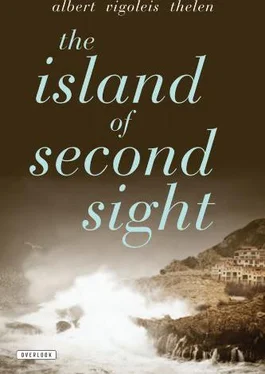We soon learned something about Pedro’s family history that he had never mentioned: during his parents’ artistic sojourn in England, in addition to his mother’s paintings and his father’s higgledy-piggledy collection of ticket stubs, brochures, museum catalogues, etc., two children made their appearance. So here and now, I am allowing these unborn creatures (which they had been for us all along) to join the ranks of humanity. I know nothing more about them. I forgot to ask Pedro about their fate, or even just about their lives. Perhaps they never crossed the Channel. When I experience something unusual in my life in this world, I never say to myself, “Aha! You can use that in your manuscript!”
At any rate, before we left the island I promised Pedro that I would fill in this gap in my memoirs, trusting at the same time that this would firm up the credibility of my jottings. For it is difficult enough to separate the rock-hard reality of certain of my characters from the ostensibly shameless dissimulation that can likewise be found in my account. All of it had to be written down just as someone experienced it, especially if this someone was prone to fall for other people’s prevarications. Many of the personages in my book took me and my Vigoleis for suckers. We were fooled — thereby enriching my life, by the way, and eventually that of my recollections. Poetry and Truth , ‘bizarre mystification’ and reality — I play my games with what I have actually experienced, to the despair of scholarly exegetes of the picaresque novel, those who insist upon the fictionality of my ‘Applied Recollections,’ although in the process they themselves are striding out on the path of untruth.
All this loquacity, some readers might be thinking, just for the sake of two nameless human offspring? Yes, indeed. By reason of their right to life they belong in my book, where, Lord knows, so much weirdness has been left out. Consider, if you will, that I excised a good 500 pages from a manuscript that took me exactly nine months to produce. In keeping with my penchant toward nihilism, I burned them in the coal stove in our apartment on Helmersstraat in Amsterdam: an anti-herostratic, barbaric act that caused unspoken distress for Beatrice, but one that to this day she has never held against me.
Barbaric? Perhaps. But is this the dangerous “Perhaps” to be found in Nietzsche’s Beyond Good and Evil ? In case of doubt, let truth once more be told.
Lausanne-Vennes, on the street of the poet Ysabelle de Montolieu, Spring 1981
The Great Unknown Figure of German Literature
The surprise could not have been greater when, in the autumn of 1953, a completely unknown author mounted the German literary stage and presented a 1,000-page book. This fellow was already fifty years old, and he arrived on the scene with multifarious life experiences, accumulated in no less than five different countries. He was German, but he lived in Amsterdam. In addition to his mother tongue, he was fluent in five other languages: Spanish, Portuguese, Dutch, French, and English. Up to now, he had barely made a name for himself — other than a few poems and translations, he had published nothing at all. So it was that readers and critics were astounded to confront a work that surpassed established norms for quantity and quality. This writer hit the literary world like a meteorite — gigantic, weighty, as if hailing from some alien place.
Not everyone was prepared to welcome this intruder. But many who paid closer attention to him were enthusiastic, and have remained so. Among these was the writer Siegfried Lenz, who wrote in 1954: “There’s no disputing that this book just must be read. If ever a book deserved to be called a major event, this one is it.” A short time later, in a letter to his wife, the poet Paul Celan wrote, “I have just read a new German novel, which looks to me like a genuine work of art.” And finally, writing in Die Zeit in 1999, the best-selling Dutch author Maarten ‘t Hart exceeded all the previous hymns of praise: “For a long time I have believed that the greatest book of the current century is The Island of Second Sight by Albert Vigoleis Telen.”
Given such a cascade of praise, it is all the more curious that Thelen is no longer quite visible as a writer. In fact, it is quite puzzling that as the author of one of the best books of the twentieth century, he counts among the great unknown writers of our time. In 1953, he came forth with a work that had no comparable German analogue in its linguistic virtuosity, depth of experience, and narrative variety. But the major critics in Germany were writing about very different books. In the current histories of German literature, as in the major reference works on the same subject, Thelen is mentioned, at best, in passing. But if there are important literary discoveries to be made as we look back on the last century, we must surely cite his name and that of his magnum opus: Albert Vigoleis Thelen and his Island of Second Sight .
Just who is this “Thelen,” the man who tells us so many stories, and whose life could provide material for several Hollywood films? Who is this impoverished writer, who accomplished so much but who has remained virtually unknown? Whose name is no longer mentioned in the popular media, but gets passed around as a secret tip for connoisseurs? It is not my intention to explain in every detail the history of this author’s magnificent achievement and his wrenching lack of success, but I wish at least to point out the most important phases of his life.
Born on September 28, 1903, Thelen grew up in a comfortable but decidedly un-literary environment — more petit-bourgeois than cosmopolitan. Süchteln, his Lower Rhine hometown, could not offer him what he needed for his true development, and his three brothers treated him as an antisocial bookworm. The fact that he liked to write things down was considered by his family as something to be tolerated, but also as an activity beyond their ken. They thought him a stranger in their midst; his parents must have wondered about what would become of this boy.
What then took place is what generally happens under such circumstances. At first, the black sheep of the family moves around from job to inappropriate job, only to arrive at the conclusion that he is a complete failure. With Thelen, this meant training as an auto mechanic, followed by a course in technical drawing, attendance at a vocational school for textile workers, and, eventually, university study in the fields of German language and literature, print media, philosophy, and Dutch philology. Young Thelen pursued these studies in Münster and Cologne.
All this activity was not for naught, and his achievements were duly recognized. But this was not what he was after. He wanted to live literature, to live language. He wanted to translate and to write for himself. He had been a writer since childhood, but most of what he wrote was either destroyed by his own hand, or had received rejection notices from literary periodicals. What he needed, clearly, was some sort of fundamental reorientation, which would let him reach the goals he was aiming for. He would have to bring about this kind of change by himself.
In 1931—the year that was to become the most significant turning point in his life — he changed his name and left Germany.
Both of these events were of signal importance for him. His past life now behind him, he immersed himself in a string of new experiences. The things he now went through were, for the most part, happenstance. He left behind little Albert Thelen from Süchteln, and now declared as his second name the nickname bestowed on him by fellow students in the German Seminar at Münster University. The subject of this graduate course was the medieval verse epic Wigalois , by Wirnt von Gravenberg. The hero of this set of exploits, whose name Thelen adopted as his own, rides forth at the age of twenty to enter into a series of adventures. In the end, as compensation for his exemplary moral behavior, he leads a life of pleasure and contentment. Because the name “Alois” sounded too German to him, Thelen modified slightly his student-era nickname, from “Wigalois” to “Vigoleis.” From then on, this name became for him a new identity, one that he held on to until his very last days. “Vigoleis,” “Vigo,” and, in Spain, “Don Vigo,” was forevermore his true name. He published his written works under this name, and he turned “Vigoleis” into an alter ego, into the hero of his books.
Читать дальше












